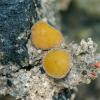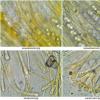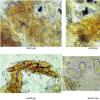
29-12-2015 19:27
 Bernard CLESSE
Bernard CLESSE
Sur place à feu. a) poils septés, brun clair, c

28-12-2015 15:17
Thorben HülsewigHi there,yesterday i found a white funghi on Pinus

29-12-2015 00:41
Hi to everybody I need your help with this fungus

28-12-2015 05:24
Collected 24 december 2015, on Ulmus americanus ba

28-12-2015 10:39
 Joop van der Lee
Joop van der Lee
Found on cow dung.Apothecia: 2.67 mm in diameter;

27-12-2015 14:04
 Bernard CLESSE
Bernard CLESSE
Bonjour à tous,Voici un Hypocrea venant sur branc

26-12-2015 13:08
Nina FilippovaDear colleagues,I would appreciate your help in fi

27-12-2015 16:40
Cvenkel MiranphotoIn beetween oak log & ground. From far it

25-12-2015 20:55
Gernot FriebesHi,in September I found this earth tongue in Liech
 Sur place à feu.
Sur place à feu.a) poils septés, brun clair, clavés au sommet
b) spores elliptiques biguttulées : 18,5-19x8,5-11
c) paraphyses enflées au sommet, bifurquées vers le tiers supérieur
Je pense à Anthracobia nitida. Quel est votre avis ?
Bernard


